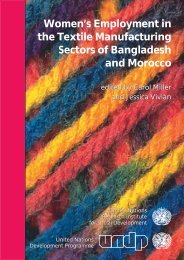RESEARCH REPORT 4 Paid Care Workers in Tanzania:
RESEARCH REPORT 4 Paid Care Workers in Tanzania:
RESEARCH REPORT 4 Paid Care Workers in Tanzania:
Create successful ePaper yourself
Turn your PDF publications into a flip-book with our unique Google optimized e-Paper software.
Support<strong>in</strong>g the dispensaries are health centres. These are supposed to give priority to<br />
preventive measures and hygiene education but <strong>in</strong> reality they are extensively used for<br />
treatment of common diseases. Most of the health centres have room for m<strong>in</strong>or surgery and<br />
provide 20-30 beds for <strong>in</strong> patients <strong>in</strong>clud<strong>in</strong>g maternity cases. A health centre is run by a<br />
Medical Assistance (M.A) with secondary education with more elaborate education <strong>in</strong><br />
diagnosis and treatment as well as tra<strong>in</strong><strong>in</strong>g <strong>in</strong> m<strong>in</strong>or surgery. This is of higher grade then the<br />
rural medical aid. The medical assistant is normally assisted by one or two rural medical aids,<br />
a nurse/midwife with one or two maternal and child health aids and health assistant. In the<br />
cont<strong>in</strong>uum of care the Medical Assistant would provide treatment to the PLWHA who has<br />
been referred to by the RMA. The PLWHA might be admitted for treatment or for further<br />
diagnoses.<br />
Above the health centre there is a district hospital. This is the base for staff<strong>in</strong>g and supply<strong>in</strong>g<br />
all rural units with equipment, and medic<strong>in</strong>e. Generally, there is one district hospital per<br />
adm<strong>in</strong>istrative unit and it is the district hospital that any difficult or serious case is referred to<br />
from the lower levels. The district hospitals are provided with medical doctors one or more<br />
depend<strong>in</strong>g on the size, stores for drugs and equipment, and a diagnostic laboratory, ex ray,<br />
operation facilities and beds for referred patients. Each district has a Health Management<br />
Team (DHMT). The DHMT is expected to ma<strong>in</strong>stream HBC services <strong>in</strong> the health services.<br />
Above the district is a regional hospital. Strictly the regional and district hospitals are similar<br />
except that the regional hospital has more facilities and more highly skilled health personal<br />
that is 5-10 doctors <strong>in</strong>clud<strong>in</strong>g one specialist. The highest level is the national referral<br />
hospitals, endowed with more sophisticated equipment, more specialists, and more staff<strong>in</strong>g<br />
across all cadres.<br />
The HBC program is premised on the assumption that a functional referral system is <strong>in</strong> place,<br />
and that resources for HIV&AIDS will trickle down to the households with PLWHAs<br />
particularly the poorest households. Additionally, it is further assumed that there will be<br />
<strong>in</strong>dividuals with<strong>in</strong> and outside the households who will be will<strong>in</strong>g to volunteer to provide<br />
needed care for the bedridden patients <strong>in</strong> their households. Although the HIV&AIDS is<br />
supposed to be multi sectoral, the care services highly depend upon the health care facilities.<br />
This seems to have overstretched the human resource capacities of the health facilities which<br />
were already experienc<strong>in</strong>g a human resource crisis.<br />
One of the major challenges limit<strong>in</strong>g the implementation of health policies and particularly<br />
the HIV&AIDS programmes <strong>in</strong>clud<strong>in</strong>g care and treatment is lack of qualified human<br />
resources <strong>in</strong> the health sector. While data on the size of health workers by category is not<br />
easily available <strong>in</strong> <strong>Tanzania</strong>, all exist<strong>in</strong>g literature and political pronouncements <strong>in</strong>dicate a<br />
human resource crisis <strong>in</strong> the health sector. The CMI report (2006) asserts that <strong>Tanzania</strong> has<br />
the word’s lowest coverage of physicians, with only 0.02 medical officers or specialist per<br />
1,000 persons (CMI: 2006: 4). Additionally, at a Jo<strong>in</strong>t Health Sector Review <strong>in</strong> 2004, the<br />
Permanent Secretary of M<strong>in</strong>istry of Health declared that <strong>in</strong> …. “the area of human resources, I<br />
believe we have now reached a crisis po<strong>in</strong>t”. At the Annual Review of 2005, M<strong>in</strong>ister of<br />
Health asserted that the crisis now has reached emergency proportions. In his address to the<br />
Regional Medical Officers <strong>in</strong> 2005, the then President of the United Republic of <strong>Tanzania</strong> His<br />
Excellency Benjam<strong>in</strong> Mkapa is quoted to have said” the shortage of health personnel … “is a<br />
serious problem, which requires urgent steps.” (CMI report: 2006: 9).<br />
Accord<strong>in</strong>g to the Human Resource Health (HRH) census <strong>in</strong> 2001/02, the size of active supply<br />
of health workers was 49,900 (MoH: 2004), which translates <strong>in</strong>to staff per population ratio of<br />
148 per 100,000. In 1994/95, active supply was approximately 67,600 health workers (census<br />
4
















